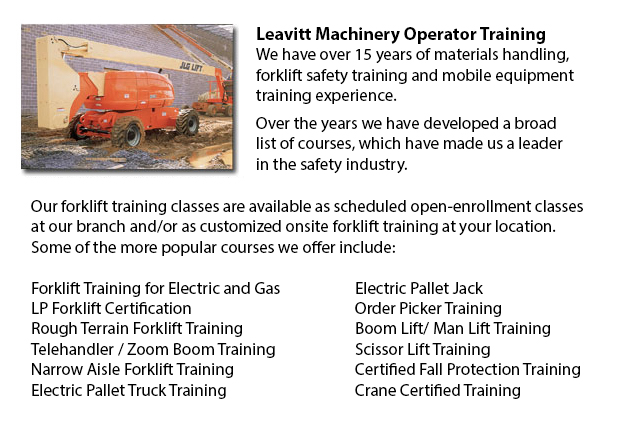
Cambridge Boom Lift Safey Training - Boom lifts fall under the kind of aerial lifting device or elevated work platform. Most commonly used in construction, industry, and warehousing; the boom lift is very versatile that it can be utilized in practically any setting.
Elevated work platforms allow workers to access work areas that would be not reachable otherwise. There is inherent danger in the operation of these devices. Employees who operate them must be trained in the right operating procedures. Accident prevention is vital.
Boom Lift Training Programs cover the safety aspects involved in boom lift operation. The program is best for those who operate self-propelled boom supported elevated work platforms and self-propelled elevated work platforms. Upon successful completion of the course, Individuals who participated would be issued a certificate by someone qualified to verify finishing a hands-on evaluation.
To help train operators in the safe utilization of elevated work platforms, industry agencies, federal and local regulators, and lift manufacturers all play a role in providing the necessary information and establishing standards. The most important ways to prevent accidents associated to the use of elevated work platforms are as follows: conducting site assessments; checking equipment; and having on safety gear.
Vital safety factors when operating Boom lifts:
Operators should observe the minimum safe approach distance (MSAD) from power lines. Voltage can arc across the air to be able to find an easy path to ground.
A telescopic boom should be retracted before lowering a work platform so as to maintain stability as the platform nears the ground.
Boom lift workers must tie off to ensure their safety. The harness and lanyard apparatus must be connected to manufacturer provided anchorage, and never to other poles or wires. Tying off may or may not be required in scissor lifts, depending on particular employer guidelines, job risks or local regulations.
Avoid working on a slope that goes beyond the maximum slope rating as specified by the manufacturer. If the slop exceeds requirements, then the machinery must be transported or winched over the slope. A grade can be easily measured by laying a straight edge or board of at least 3 feet on the slope. After that a carpenter's level could be laid on the straight edge and the end raised until it is level. The percent slope is attained by measuring the distance to the ground (likewise called the rise) and dividing the rise by the length of the straight edge. Next multiply by 100.
-
Cambridge Aerial Boom Lift Ticket
Cambridge Aerial Boom Lift Ticket - Aerial lifts can accommodate many tasks involving high and hard reaching places. Often used to perform routine upkeep in structures with elevated ceilings, prune tree branches, raise burdensome shelving units or me... More -
Cambridge Heavy Equipment Training
Cambridge Heavy Equipment Training - The two most common types of heavy equipment training are classed into the categories of machines; equipment that is fashioned with tracks and those with rubber tires. The tracked vehicle are heavy duty equipment... More -
Crane / Overhead Crane / Self-Erect Crane / Truck Mounted Crane / Hydraulic Cranes Training in Cambridge
Overhead cranes are likewise referred to as bridge cranes. They are a type of crane that has a hook and line mechanism which runs along a horizontal beam which runs along two widely separated rails. Several overhead cranes could be found in a long fa... More -
Cambridge Warehouse Forklift Training Classes
Cambridge Warehouse Forklift Training Classes - The reason for warehouse training classes are to raise the awareness of common workplace hazards. Those training would learn necessary warehouse safety procedures. An emphasis is placed on paying attent... More -
Cambridge Heavy Equipment Training School
Cambridge Heavy Equipment Training School - The heavy equipment operator courses would assist the operator in attaining the needed skills and knowledge they would need to be able to enter the workforce as an entry level operator. In this 12 week cour... More -
Cambridge Telehandler Training
Cambridge Telehandler Training - Telehandlers or also called Telescopic handlers are really popular piece of heavy construction machinery most often utilized in construction and agricultural industries. These machines have maximum reaching ability an... More -
Cambridge Boom Lift License
Cambridge Boom Lift License - To operate an aerial boom lift, operators should be certified through training which can be attained utilizing both practical training and classroom sessions and by attaining a boom lift license. Instruction must be give... More -
Cambridge Wheel Loader Training
Cambridge Wheel Loader Training - Normally, the various kinds of heavy equipment training are divided into 2 categories of equipment: those which have rubber tires and tracked vehicles. Tracked vehicles consist of items such as excavators, cranes, an... More

Forklift Certification Cambridge
TOLL FREE: 1-888-254-6157
Cambridge, Ontario
forkliftcertificationcambridge.com
Email Us
About Us


